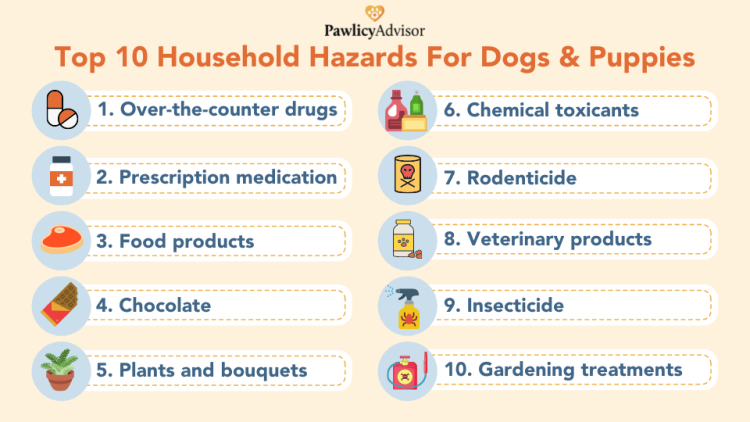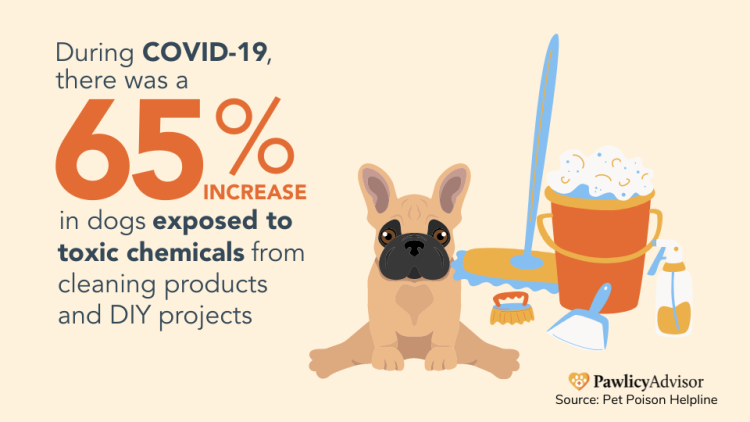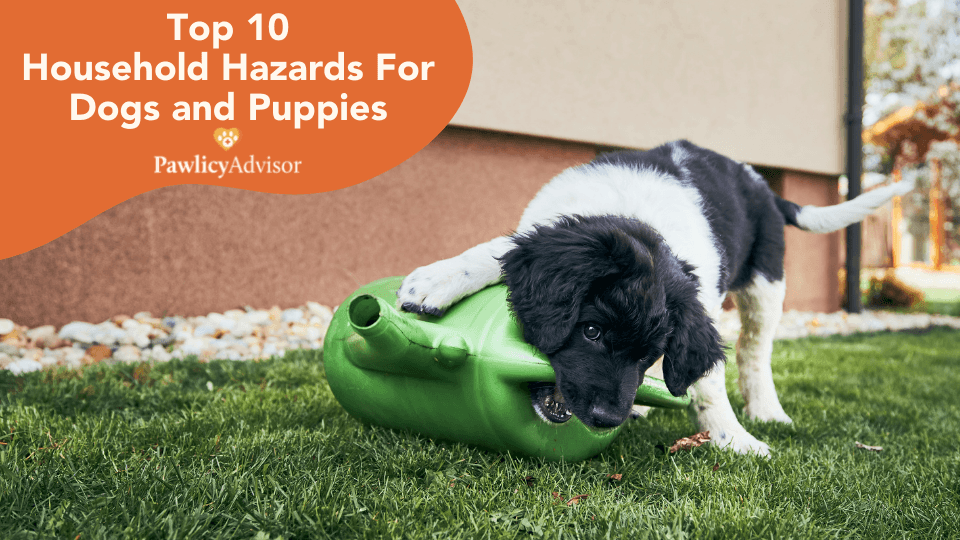Whether you just got a new puppy, are an experienced pet parent, or pet-sit part-time, it’s your responsibility to do everything you can to keep your four-legged friend safe and healthy. But did you know that there’s an inventory of hazards lurking in your own home?
Protect Your Puppy with Pet Insurance Get the New Puppy Checklist
Puppy-proofing your house starts with identifying the potential hazards for puppies then removing or securing them to protect your pet.

Below, we’re going over the most common household hazards for dogs and puppies, according to the ASPCA Animal Poison Control Center (APCC).1 These are the top 10 calls they receive for poisoning in puppies with advice on how you can make your home a safer place for your pup:
- Most Common Household Toxins For Dogs
1. Over-the-counter drugs
2. Prescription medication
3. Food products
4. Chocolate
5. Plants and bouquets
6. Chemical toxicants
7. Rodenticide
8. Veterinary products
9. Insecticide
10. Gardening treatments - Additional Hazards For Puppies Around The House
- What To Do If You Suspect Pet Poisoning
- Key Takeaways
Most Common Household Toxins For Dogs
1. Over-the-counter drugs
Human-grade drugs available over-the-counter (OTC) top the list of toxins in dogs for the third year in a row, making up approximately 17% of ASPCA's total call volume.2 The most common items in this category include human pain medication unsafe for dogs (like naproxen and aspirin), vitamins and supplements, and cold medicine. If your dog swallows large doses of human OTC drugs, it can result in vomiting, diarrhea, lethargy, decreased appetite, increased drinking and urination, severe stomach ulcers, and kidney failure.
2. Prescription medication
According to data from ASPCA, dogs and puppies consume toxic cardiac, anticonvulsant, and antidepressant prescriptions most commonly. Similar to OTC medications, prescription drugs can result in gastrointestinal (GI) problems, cardiac arrhythmias, blood pressure changes, or even kidney failure, so be sure to secure them in cabinets out of your pet’s reach.
3. Food products
Food products make up 13% of all toxicosis in canines at the APCC. Foods that create the highest call volume include protein and snack bars, grapes, products containing xylitol, onions, and garlic. The list of unsafe foods for dogs also includes:
- Avocado (pit and skin)
- Alcohol
- Coffee and caffeine
- Some citrus fruits
- Milk and dairy
- Most nuts (especially walnuts)
- Raw or undercooked bones, meat, and eggs
- High-sodium foods
- Raw yeast (dough)
4. Chocolate
ASPCA's Animal Poison Control Center (APCC) deals with a whopping 76 cases of chocolate toxicity per day. Many pups have a hard time resisting this delectable sweet, even though chocolate is toxic to dogs due to a compound called theobromine — an ingredient they’re unable to metabolize effectively, leading to a buildup of by-product waste in the blood stream.

Although chocolate is rarely fatal to dogs, canine chocolate ingestion can result in significant illness. If your pet eats chocolate, be sure to keep an eye on them and seek veterinary attention if they show any signs of GI distress or neurological issues.
5. Plants and bouquets
Both outdoor and indoor plants can pose a threat to your four-legged friend. Some of the most common plants that are toxic to dogs include:
- Sago palms
- Azaleas
- Lily of the Valleys
- Oleanders
- Philodendrons
- Rhododendrons
- Daffodils
- Tulips
- Birds of Paradise
- Hyacinths
6. Chemical toxicants
The most common household toxicants for dogs include cleaning, beauty, and home repair products. During the COVID-19 pandemic, the Pet Poison Helpline saw a 65% increase in calls related to cleaning and disinfecting products.3 As people tried to protect themselves from the virus, dogs got sick or injured from the heavy exposure to strong chemicals around the home.

The sharp increase can also be explained by the prevalence of toxic materials used in various home improvement projects people took on while social distancing, such as paint or adhesive, as well as the statistical rise in pet ownership throughout the pandemic.
Other less common, but equally dangerous pet toxins include include chemicals such as:
- Antifreeze
- Bar soap and face wash
- Fabric softener sheets
- Petroleum jelly
- Cigarettes
- Marijuana
No matter how careful you are with products like laundry detergent, window cleaner, or antibacterial wipes, each dog has a unique sensitivity and accidental exposure is always a risk.
Pet insurance is extremely useful in these unexpected situations, because it allows you to immediately get your dog the critical vet care they need, without thinking twice about the potential treatment price and whether it's actually necessary.
Explore Health Insurance For Dogs How Does Pet Insurance Work?
7. Rodenticide
Rodenticide has an enticing flavor designed to attract rodents, but it seems to also attract dogs. Once ingested, the poison can cause a variety of symptoms, ranging from vomiting to organ failure. If left untreated, rodenticide can also result in death, therefore it is extremely important to prevent your pet from coming into contact with this toxic substance.
If you suspect your dog or puppy got into rodenticide, immediately call the APCC or Pet Poison Control and carefully describe the product label in full detail. It’s critical the person knows exactly which active ingredients are used in your product at home, because there are several different types, each with unique symptoms.
8. Veterinary products
Pets might find veterinary products like herbal calming chews or glucosamine supplements for dogs very tasty. Some medications including anti-inflammatories are flavored, whereas compound medications are often made to taste like bacon or chicken — two very enticing flavors to canines. After their first taste, they might be tempted to return to the container and consume a toxic amount. It may sound counterintuitive, but overdose on veterinary products can cause serious illness and even death, so always be sure they are securely out of your pet’s reach.
9. Insecticides
Toxic levels of insecticides like mosquito repellant, bug sprays, and ant baits can cause vomiting, respiratory arrest, and seizures in your pet. Even if the bait used in roach and/or ant traps happens to not be toxic, dogs might choke on the traps themselves. Fly, slug, and snail poisons can also be very dangerous to pets around the home.
10. Gardening treatments
Lawn and garden treatments like fertilizer or weed-killer often contain harmful substances (i.e. pesticides, herbicides, and fungicides) within hazardous compounds (nitrogen, phosphorous, etc.) that can be highly toxic when consumed in large amounts. Complications can include stomach irritation, mouth burns, and severe toxicosis, so keep dogs far away from fresh landscaping.
Additional Hazards For Puppies at Home
FDA guidelines suggest the following safety protocols for puppy hazards:4
- Electrical cords: Electrocution from chewing on electrical cords is the most common type of electrical injury for household pets, and it can also cause choking.
- Open heat sources: If your dog gets access to an open heat source (such as an open fire), they run the risk of getting burned.
- Windows, balconies, and stairs: These can be dangerous places for dogs because they run the risk of falling and getting seriously injured.
- Small gaps between furniture: Puppies in particular like to den by wedging themselves in small places and could easily get stuck.
- Plastic bags: There are fatal health concerns in regard to dogs swallowing plastic bags, especially if the size of the plastic bag is larger.
- Loose coins: In addition to presenting a choking hazard for puppies, some coins contain zinc — a mineral compound toxic to dogs that can be potentially dangerous, even fatal.
- Hair ties: Foreign objects like hair ties can tear or puncture your pet’s intestinal walls leading to potentially life-threatening infection and inflammation.
- Socks: If your puppy has swallowed a sock, there’s a good chance it’ll become stuck in their digestive tract, known as a life-threatening condition called “intestinal blockage”.
What to Do If You Suspect Pet Poisoning
If you think your pet got into a hazardous substance in the house, watch for the common signs of poisoning in dogs. These include:
- Vomiting or decreased appetite
- Diarrhea or bloody stool
- Seizures or tremors
- Bleeding or bruising
- Changes in behavior, such as lethargy or hyperactivity
- Excessive drooling
- Changes in blood pressure
- Changes in heartbeat
- Loss of coordination
- Inflammation and swelling
- Unusual material in the feces, such as green or corn-like substances.
When in doubt, the AVMA suggests calling the 24/7 helpline for Animal Poison Control Center helpline at 1-888-426-4435.5 Depending on the situation, they might advise you to call your vet and schedule an appointment, or to take your pet to the ER for immediate veterinary care.
In times like these, pet insurance can be a literal lifesaver by reimbursing your for vet care you might not have been able to afford otherwise. The treatment for poisoning in puppies or dogs can be expensive but fortunately, pet insurance plans cover accidents including poisoning.
To prevent veterinary bills from piling up unexpectedly, start searching for pet health insurance today. Pawlicy Advisor allows you to compare pet insurance companies, evaluate policies side-by-side, and receive personalized recommendations based on the features you prefer most.
Protect your puppy by removing these pet safety hazards at home, then sign up for dog health coverage to get peace of mind in those "worst-case scenarios".
Protect Your Puppy with Pet Insurance Get the New Puppy Checklist
Key Takeaways
- In most households, doggie dangers are around every corner. The most common hazardous items for pets at the home include human medications, unsafe food, poisonous plants, and toxic chemicals.
- Although many of these items must be kept as necessities, you can store them in places that your pet cannot access, such as locked drawers or cabinets.
- If you suspect your dog has gotten into something they shouldn't have, call Animal Poison Control Center or your vet right away for their risk assessment.
- Dog insurance can help lower the cost of vet bills if your curious puppy consumes anything toxic, so you can stress less over the vet bill and making sure you're loved one has a speedy recovery.
References
- ASPCA, "Official Top 10 Pet Toxins" Accessed Apr. 27, 2022.
- ASPCA, "Poisonous Household Products" Accessed Apr. 27, 2022.
- AVMA, "Pet Poison Control Calls Rise with COVID-19 Related Cleaning" Accessed Apr. 27, 2022.
- FDA, "Potentially Dangerous Itemns For Your Pet" Accessed Apr. 27, 2022.
- AVMA, "Household Hazards" Accessed Apr. 27, 2022.
